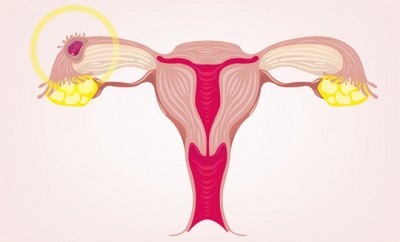Implantation Bleeding – Top 5 Signs Indicating Early Pregnancy!
Implantation bleeding during the first trimester is a normal physiological process. It`s important to know its characteristic features in order to confirm pregnancy as early as possible. Gynecologists say that implantation spotting occurs one week before regular menstruation, it is slight and pinkish in color, are these statements true?
Implantation Spotting: Normal or Abnormal?
Implantation bleeding during the first trimester of pregnancy signifies the beginning of the egg attachment to the uterine wall lining. A brownish or pinkish bloody discharge usually occurs several days before the regular period. Such type of bleeding can be also called “implantation spotting“. This term characterizes it even more precisely. Brownish or pinkish pre-menstrual discharge with blood is mostly a clear indicator of pregnancy. Correctly recognizing the signs of implantation spotting will help you to distinguish it from a normal menstrual cycle.
Of course, there are a lot of women, who know some information about implantation spotting. However, many of them aren’t aware of all the probable signs of this type of bleeding. The majority of women know only that a brownish or pinkish discharge with blood drops could occur during pregnancy about one week prior to their next menstrual date. But it`s not enough. It is very important to know all the symptoms of implantation spotting in order not to confuse it with a normal period.
Signs of Implantation Spotting
Here’s a list of the top 5 signs of implantation spotting, indicating early pregnancy:
1. Implantation bleeding occurs a week before your next menstrual date.
Implantation blood is usually noticed in the form of a minor spotting. It typically takes place before the next regular menstrual cycle. An average menstruation period is likely to begin on the 14th day after the ovulation date. However, if conception really takes place, the bleeding connected with it occurs somewhere between the 6th and the 12th day post fertilization. Keep in mind, that every woman has its personal menstrual cycle. Hence, a 14th day calculation may vary.
In other words, egg embedment tends to happen on the 3rd or the 4th week after your last period. Implantation spotting in most cases lasts for a short period of time. For example, for a few minutes or a couple of hours. It can also last for several days, from 1 to 3 maximum. Often, in some rare cases, if the bleeding is irregular, it may even last for a few days longer than usual. But it`s rather abnormal than normal.
2. Implantation bleeding is unlike a regular period.
Implantation spotting is a fairly scanty discharge that occurs through the vagina. Also, it is pink or brown in color instead of a red color blood flow during woman`s regular period cycle. Such discharge does not intensify and ends after a few hours or 2-3 days. Menstruation usually lasts 3-7 days, the blood flow is heavy.
3. Implantation spotting is usually accompanied by other signs of pregnancy.
It is much easier to confirm your pregnancy if the above mentioned signs of implantation are accompanied by other pregnancy symptoms. For example, by nausea, fatigue, frequent urination, vomiting, stomach bloating, raised sensitivity to smells and breasts tenderness.
Sometimes there may be no other signs of pregnancy, accompanying implantation bleeding. However, many women notice mild cramping in their lower belly during this period. These feelings are often accompanied by a slight rise in the basal body temperature. Therefore, women are encouraged to use a basal thermometer for menstrual cycle to easily identify pregnancy at the earliest stage. While resting or sleeping, the temperature will be at its lowest level. However, in case you feel intense abdominal and vaginal pains during even the slightest bleeding, it is not a healthy sign.
If you feel something goes wrong, you must visit your gynecologist immediately to rule out the possibility of an ectopic pregnancy or early miscarriage. Keep in mind, even the slightest indication of such abnormalities can transform into serious complications. For example, ectopic pregnancy occurs when the fertilized egg or embryo mistakenly implants into the fallopian tube, ovary, stomach or cervix instead of the wall lining of the uterus. A majority of all ectopic pregnancies take place within the fallopian tubes. Such pregnancies are terminated.
4. Implantation spotting can be accompanied by cramping.
Mild cramping can be experienced by you along with implantation spotting and it usually vanishes in just a few months after conception. However, in few cases, it has been seen that these cramps could remain right until the delivery day. The good news is that the cramps associated with implantation spotting, are fairly mild. They typically start a week before the next menstrual date. Remember, if you have a successful conception, implantation spotting and cramping are a fairly normal occurrence. However, cramps could also take place even when implantation hasn’t occurred. Such spasms are experienced when a fertilized egg contracts the uterus muscles while implanting. This contraction may sometimes induce cramping, even if there isn’t any spotting. If cramping and implantation bleeding continue for more than three days, it is recommended to do a pregnancy test and to schedule an appointment with a specialist to discuss the matters.
5. Implantation spotting along with a missed period.
Depending on which day of your menstrual cycle were you on when your period flow stopped, as well as your luteal phase and your intercourse timing, you may notice a delayed implantation spotting. If your bleeding is minor, it is usually invoked during the attachment of the fertilized egg to the uterine lining. Often, this symptom can be confused with a period, especially, when a menstruation itself has been missed. The key difference between these two phenomena is that a period flow is quite heavy and reddish in color, sometimes it contains thick clots. However, the bleeding, which occurs due to successful implantation, is scanty in quantity and pink or brown in color. This blood looks old, not fresh, as it has taken a long journey to get discarded.
Implantation Spotting Process
In order to derive oxygen for an embryo, a connection between the fertilized egg and the uterine wall lining must be provided. When this egg reaches the uterus’ inner lining (endometrium), several blood vessels can be destructed and bleeding could occur. Oxygen and nutrients are essential for the embryo’s further development and its transformation into a foetus. Implantation bleeding during this connection process is normal and there is nothing to be worried about in such case. Keep in mind, that such slight spotting is undoubtedly a clear pregnancy indicator. On the other hand, even if implantation bleeding does not occur, it still does not mean that you are not carrying a child.
Although signs of spotting usually cause concerns, research proves that almost 30% of pregnant women experience such implantation bleeding. So, the good news is that it does not pose any kind of threat for either the mother or the baby. On the other hand, its absence may alarm you also. But, then again, do not worry, just do a pregnancy test and then confirm your new condition at the antenatal clinics!
Recommended reading:
Signs Of Successful Implantation: Why It Is Important To Stay Optimistic
What Does Implantation Bleeding Look Like?
Signs of Implantation Bleeding – Implantation Bleeding and Symptoms
Is Brown Discharge a Sign of Pregnancy?
When Does Implantation Bleeding Occur?
Implantation Bleeding or Period? 5 Leading Signs of Implantation Spotting
Can Implantation Bleeding Be Bright Red Key Facts Revealed
Can You Feel Implantation? A Guide To Implantation Bleeding













